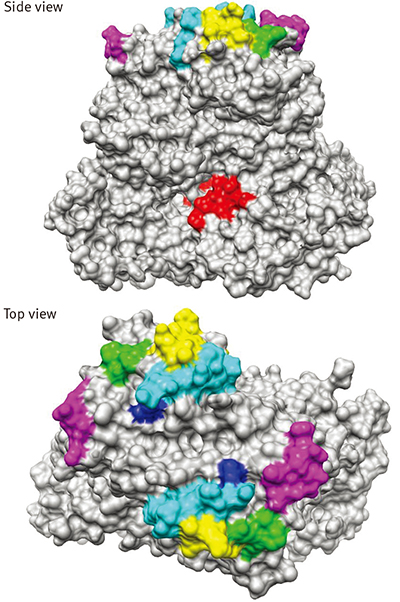(Kawasaki, Japan, 16 February 2016) Genetic mutations that occurred in the norovirus GII.17 strains circulating in Japan from 2013 to 2015 were studied by researchers affiliated with Kawasaki INnovation Gateway at SKYFRONT, Japan. In their findings published in Euro Surveillance, the researchers call for careful monitoring of the new GII.17 variant to prevent global outbreaks due to the potential of it evading the host’s immune system.
Further information about science and technology projects at Kawasaki City is available in the Kawasaki SkyFront iNewsletter that highlights research being conducted by scientists and industries affiliated with Kawasaki INnovation Gateway at SKYFRONT (KING SKYFRONT)—the City’s flagship science and technology hub focused on open innovation in the life sciences and environment.
KING SKYFRONT is located on the opposite side of the Tama River that separates Tokyo International Airport (also known as Haneda Airport) and the Tonomachi district of Kawasaki. The Airport plays an important role in the globalization of the innovative activities of scholars, industrialists and City administrators based at KING SKYFRONT.
February 2016 issue of Kawasaki SkyFront iNewsletter: https://tonomachi-ksf.kawasaki-net.ne.jp/i-newsletter/en/
Surveillance of a novel norovirus variant
Norovirus is a major causative pathogen of viral gastroenteritis in people, leading to vomiting and diarrhea. Until recently, global outbreaks of norovirus have mainly been caused by genotype GII.4. However, a new variant norovirus strain was prevalent in Japan in the winter of 2014–2015. This novel norovirus was a genotype GII.17 variant.
To investigate the genetic mutations that have occurred in the norovirus GII.17 strains, Hideaki Shimizu and co-workers at the Kawasaki City Institute for Public Health, Kanagawa, and collaborating Japanese researchers conducted whole genome sequencing of the new variant including other GII.17 strains circulating in our country from 2013 to 2015 [1].
The team used next-generation sequencing techniques to analyse six GII.17 strains that were available in Japan from 2013 to 2015. All strains were assigned to GII.17 in the VP1 gene, which codes a major capsid protein of norovirus. However, the norovirus genotyping server could not characterize RNA polymerase genotypes of the strains, which indicates the norovirus contains novel sequences. Therefore, Shimizu and his team also inferred a potential of genetic mutations within the capsid region of the strains. They named the variant as Hu/GII/JP/2014/GII.P17-GII.17.
They found that the GII.17 strain circulating in Japan in November 2014 to March 2015 was a novel variant with several amino acid substitutions in the RNA polymerase and capsid regions.
Further phylogenetic analysis of norovirus shows the emergent strain has quietly been circulating in Asia from 2013. Also, it appears to undergo an evolutionary history diverse from other previous GII.17 strains.
The researchers call for careful monitoring of the new GII.17 variant, because it may trigger global outbreaks in future due to the potential to evade the host’s immune system.
Reference and affiliations
-
- Y. Matsushima1,2, M. Ishikawa1, T. Shimizu1, A. Komane1, S. Kasuo3, M. Shinohara4, K. Nagasawa5, H. Kimura5, A. Ryo2, N. Okabe1, K. Haga6, Y.H. Doan6, K. Katayama6, H. Shimizu1.
Genetic analyses of GII.17 norovirus strains in diarrheal disease outbreaks from December 2014 to March 2015 in Japan reveal a novel polymerase sequence and amino acid
substitutions in the capsid region. Euro Surveillance 20 (26): pii=21173 (2015)
- Y. Matsushima1,2, M. Ishikawa1, T. Shimizu1, A. Komane1, S. Kasuo3, M. Shinohara4, K. Nagasawa5, H. Kimura5, A. Ryo2, N. Okabe1, K. Haga6, Y.H. Doan6, K. Katayama6, H. Shimizu1.
-
-
-
- Division of Virology, Kawasaki City Institute for Public Health, Kanagawa, Japan
- Department of Microbiology, Yokohama City University School of Medicine, Kanagawa, Japan
- Division of Infectious Diseases, Nagano Environmental Conservation Research Institute, Nagano, Japan
- Division of Virology, Saitama Institute of Public Health, Saitama, Japan
- Infectious Disease Surveillance Center, National Institute of Infectious Diseases, Tokyo, Japan
- Department of Virology II, National Institute of Infectious Diseases, Tokyo, Japan
-
-
*Correspondence: shimizu-h@city.kawasaki.jp
Figure:
Researchers at the Kawasaki City Institute for Public Health identified the novel norovirus GII.17 variant, which caused a number of cases of acute gastroenteritis in Japan in winter 2014-2015, based on whole genome sequencing.







